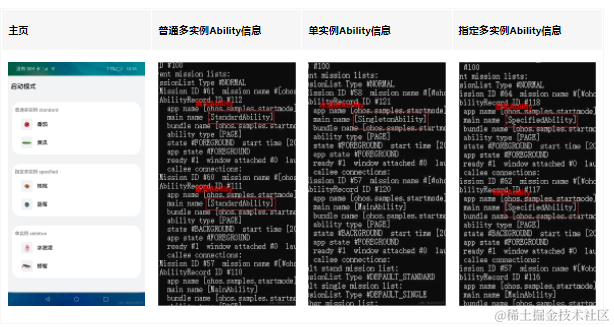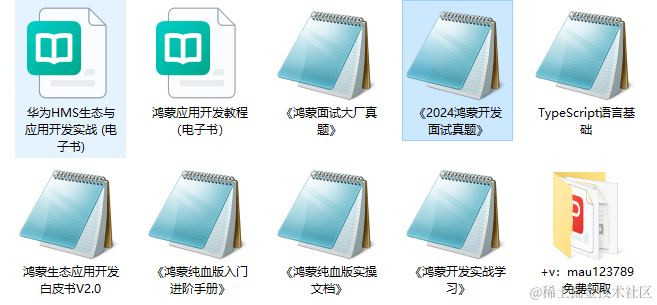

OpenHarmony鸿蒙开发学习:【Ability的启动模式】
电子说
1.4w人已加入
描述
Stage模型中,实现standard、singleton、specified多种模式场景。
本实例参考[开发指南][gitee.com/li-shizhen-skin/harmony-os/blob/master/README.md]。 本实例需要使用[aa工具] 查看应用Ability 模式信息。
效果预览

使用说明

1、standard模式:
1)进入首页,点击番茄,会新建一个番茄的Ability,展示番茄的详情;
2)在番茄的详情界面,点击黄瓜,会新建一个黄瓜的Ability,展示黄瓜的详情;
3)使用aa工具查看Ability信息,此时存在以下Ability:1个番茄的Ability、1个黄瓜的Ability、1个首页的Ability;
2、singleton模式:
1)进入首页,点击冰淇凌,会新建一个冰淇凌的Ability,展示冰淇凌的详情;
2)在冰淇凌的详情界面,点击螃蟹,会复用冰淇凌的Ability,页面数据会刷新并展示螃蟹的详情;
3)使用aa工具查看Ability信息,此时存在以下Ability:1个冰淇凌的Ability、1个首页Ability;
3、specified模式:
1)进入首页,点击核桃,会新建一个核桃的Ability,展示核桃的详情;
2)在核桃的详情界面,点击蓝莓,会新建一个蓝莓的Ability,展示蓝莓的详情;
3)在蓝莓的详情界面,点击核桃,会复用已存在的核桃的Ability,实现specified模式下的单实例特性,页面数据会刷新并展示核桃的详情;
4)使用aa工具查看Ability信息,此时存在以下Ability:1个核桃的Ability、1个蓝莓的Ability、1个首页Ability;
具体实现
- 本示例启动standard、singleton、specified三种模式的方法主要封装在Util当中,源码参考:[Util.ts]。
/*
* Copyright (c) 2022 Huawei Device Co., Ltd.
* Licensed under the Apache License, Version 2.0 (the "License");
* you may not use this file except in compliance with the License.
* You may obtain a copy of the License at
*
* http://www.apache.org/licenses/LICENSE-2.0
*
* Unless required by applicable law or agreed to in writing, software
* distributed under the License is distributed on an "AS IS" BASIS,
* WITHOUT WARRANTIES OR CONDITIONS OF ANY KIND, either express or implied.
* See the License for the specific language governing permissions and
* limitations under the License.
*/
import Logger from './Logger'
const TAG = '[Sample_StartMode]'
let contextCaller, want
interface EventHub {
emit(event: string, ...args: Object[]): void
}
interface AbilityContext {
eventHub: EventHub
}
export function getContextData(): any {
Logger.info(TAG, 'UtilPage getContextData start')
let context = getContext(this) as AbilityContext
let data = {
context: null,
launchWant: null
}
context.eventHub.emit("getAbilityData", data)
contextCaller = data.context // 拿到全局的context,即类似globalThis.mainAbilityContext
want = data.launchWant
Logger.info(TAG, 'UtilPage contextCaller ' + JSON.stringify(contextCaller))
return { 'want': want }
}
export function startMode(wantParameters: any, abilityName: string) {
Logger.info(TAG, `${abilityName} start`)
getContextData()
let want = {
bundleName: 'ohos.samples.startmode',
abilityName: abilityName,
parameters: wantParameters
}
Logger.info(TAG, `${abilityName} contextCaller ${JSON.stringify(contextCaller)}`)
contextCaller.startAbility(want).catch(err = > {
Logger.info(TAG, 'err is' + JSON.stringify(err))
})
Logger.info(TAG, `${abilityName} end`)
}
export function totast() {
AlertDialog.show(
{
message: $r('app.string.totast'),
secondaryButton: {
value: 'ok',
action: () = > {
Logger.info(TAG, 'Callback when the second button is clicked')
}
}
}
)
}
- 新建Ability:创建三个代表standard、singleton、specified模式的Ability,如工程目录中的SingletonAbility、SpecifiedAbility、StandardAbility,并在module.json文件中将launchType属性修改为对应的启动模式属性。
- 启动指定Ability:通过Util中的startMode函数根据页面所传的abilityName,启动对应的ability并进入详情页面。
- specified多实例功能实现:specified模式则是根据MyAbilityStage中的onAcceptWant函数给用户返回一个ability标识,如果之前启动过标识的ability,不创建新的实例并拉回栈顶,否则创建新的实例并启动。
审核编辑 黄宇
声明:本文内容及配图由入驻作者撰写或者入驻合作网站授权转载。文章观点仅代表作者本人,不代表电子发烧友网立场。文章及其配图仅供工程师学习之用,如有内容侵权或者其他违规问题,请联系本站处理。
举报投诉
- 相关推荐
- 热点推荐
- 鸿蒙
- OpenHarmony
-
鸿蒙Ability开发-Stage模型下Ability的创建和使用2024-01-08 1310
-
鸿蒙OpenHarmony南向/北向快速开发教程-迅为RK3568开发板2024-07-23 2344
-
HarmonyOS应用开发-Page Ability启动Service Ability2021-11-03 1091
-
OpenHarmony 应用开发快速入门2022-05-06 4506
-
OpenHarmony开发之Ability架构2022-05-12 2755
-
使用FeatureAbility模块启动其他Ability2022-09-02 5884
-
鸿蒙开发接口Ability框架:【@ohos.application.Ability (Ability)】2024-04-30 3247
-
鸿蒙开发接口Ability框架:【@ohos.ability.featureAbility (FeatureAbility模块)】2024-05-06 1701
-
鸿蒙开发接口Ability框架:【(AbilityDelegator)】2024-05-13 1497
-
鸿蒙开发接口Ability框架:【AbilityDelegator】2024-05-16 1459
-
鸿蒙Ability Kit(程序框架服务)【UIAbility组件启动模式】2024-06-06 1890
-
如何在开源鸿蒙OpenHarmony开启SELinux模式?RK3566鸿蒙开发板演示2024-11-18 1331
-
OpenHarmony怎么修改DPI密度值?触觉智能RK3566鸿蒙开发板演示2024-12-24 1134
-
OpenHarmony源码编译后烧录镜像教程,RK3566鸿蒙开发板演示2024-12-30 1596
-
鸿蒙北向开发OpenHarmony5.0 DevEco Studio开发工具安装与配置2025-03-28 1408
全部0条评论

快来发表一下你的评论吧 !

